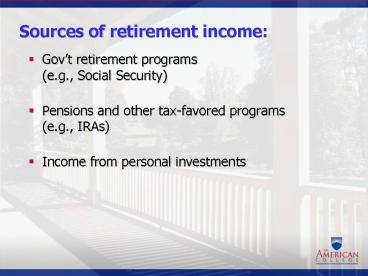Sources of retirement income:
1 / 25
Title:
Sources of retirement income:
Description:
p = percentage of salary contributed to the pension account, and ... It is assumed that the pension contribution is made at the beginning of each ... – PowerPoint PPT presentation
Number of Views:51
Avg rating:3.0/5.0
Title: Sources of retirement income:
1
Sources of retirement income
- Govt retirement programs (e.g., Social
Security) - Pensions and other tax-favored programs (e.g.,
IRAs) - Income from personal investments
2
If work one more year, Net Salary equals
- Salary
- Present Value of Increased Pension benefits
- One year worth of pension
3
Decision to retire based on
- Utility of net salary
- vs.
- Utility of one extra year of leisure
4
Paper focuses on how ones pension plan (DB vs.
DC) tends to affect the retirement decision
5
Equation (1) definition of terms
6
Equation (2) definition of terms
where I1 present value of the combination of
salary and benefits if the employee retires one
year from today, and g percentage increase in
"final" salary for next year.
7
Equation (3)
The "net salary" or marginal economic benefit of
working one more year is the difference between
I1 and I0
8
Equation (4)
This difference can be "simplified" to the
following form
9
Table 1, lines 5, 10, 15, 20, 25, and 30
10
Sensitivity of the coefficient term to its
parameters
- Discount rate has negative impact
- Benefit per year worked depends on life
expectancy - Number of years a person has worked is negative
provided g lt k - Life expectancy is positive
11
Equation (6) definition of terms
12
Equation (7) definition of terms
where p percentage of salary contributed to
the pension account, and i rate of return the
employee expects to earn on the pension
account. It is assumed that the pension
contribution is made at the beginning of each
year when the employee is paid.
13
Why j should be less than k
- Cost of running a pension fund
- Risk of annuitization
14
Equation (8)
15
Equation (9)
16
Equation (10) definition of term
This derivation requires the assumption that
working one more year does not alter the expected
date of death. Hence, the annuity factor used by
the pension provider for a person retiring today
(AFQ,j) differs from the annuity factor that
would be used one year later (AFQ-1,j) by a
factor of exactly one year.
17
Table 2, lines 5, 10, 15, 20, 25, and 30
18
Equation (11)
19
Equation (12)
20
Equation (13)
21
Sensitivity of the coefficient term to its
parameters
- of salary contributed is positive
- investment yield is positive
- discount rate has negative impact
- impact of m is ambiguous
22
Summary Regardless of pension type
- The longer one expects to live, the higher the
net salary - The higher the discount rate, the lower the net
salary - The one year salary increase has minimal effect
23
Summary DB plans
- The longer one has been in the plan, the lower
the net salary - Coefficient is relatively stable
24
Summary DC plans
- Impact of m depends on life expectancy
- More variation in coefficient
25
Summary Final
- People are more likely to retire under DB plans
- People are more likely to continue working under
DC plans































